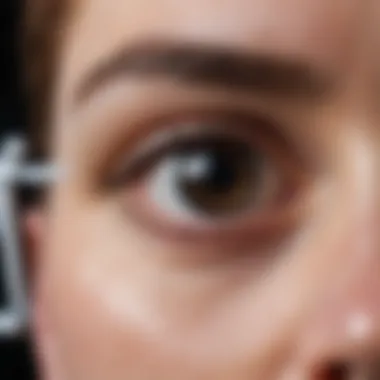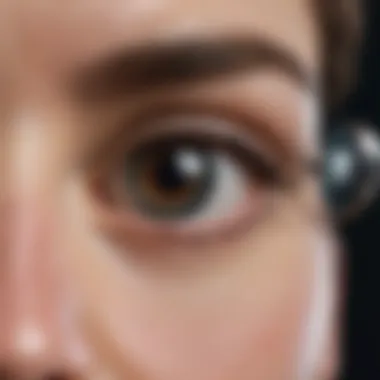Understanding PRK Eye Surgery Price: A Comprehensive Guide


Intro
The decision to undergo PRK eye surgery can be momentous, especially when considering the financial implications. This procedure, designed to enhance vision through laser correction, holds significant value for many individuals. However, grasping the components of its pricing is crucial for making informed choices. This guide delves into the multifaceted aspects that shape the cost of PRK eye surgery, ensuring prospective patients understand what influences these expenses.
Overview of Financial Product
Definition of product
PRK, or Photorefractive Keratectomy, is a type of eye surgery aimed at correcting refractive vision errors. Understanding its financial aspects is not just about the surgery itself but also about uncovering the economic landscape that surrounds it. The term
Prelims to PRK Eye Surgery
PRK eye surgery, or photorefractive keratectomy, represents a significant alternative for individuals seeking corrective vision solutions. Understanding this surgery is crucial as it helps potential patients to navigate the complex landscape of vision correction options. In this article, we will delve deep into what PRK entails, its comparison with other procedures, and key factors that affect pricing. This foundational knowledge arms individuals with the insights necessary for making informed decisions about their eye care.
What is PRK Eye Surgery?
PRK eye surgery is a type of refractive surgery aimed at correcting vision problems such as myopia, hyperopia, and astigmatism. Unlike LASIK, PRK does not involve the creation of a corneal flap. Instead, it uses a laser to remove a thin layer of corneal tissue. This process reshapes the cornea to enhance its focusing power. Typically, the surgery is performed on an outpatient basis, allowing patients to return home shortly after.
The procedure starts with the application of numbing eye drops to ensure comfort. Afterward, the surgeon uses an excimer laser to reshape the cornea. The recovery period can take several days, during which the surface of the cornea heals. Patients often experience blurred vision initially, but clarity usually improves over time.
How Does PRK Compare to Other Vision Correction Procedures?
Comparing PRK with other vision correction surgeries helps in understanding its unique position in eye care. Here are a few key aspects:
- Corneal Flap Creation: Unlike LASIK, which involves creating a flap in the cornea, PRK is flapless. This can be a benefit for patients with thinner corneas or those involved in contact sports.
- Recovery Time: PRK typically has a longer recovery time than LASIK. While LASIK patients may see immediate improvements in vision, PRK may require several days for vision stabilization.
- Pain and Discomfort: Patients may experience more discomfort after PRK compared to LASIK. Numbing drops help, but some soreness is expected.
- Stability of Results: PRK can provide long-lasting results similar to LASIK, but individual outcomes vary based on eye health and specific vision conditions.
Ultimately, the choice between PRK and other procedures depends on several factors, including individual eye health and lifestyle requirements. By understanding these differences, potential patients can better assess which surgical option is suitable for their vision correction needs.
Factors Influencing PRK Eye Surgery Price
Understanding the price of PRK eye surgery is crucial for potential patients. The costs associated with this procedure can vary significantly based on numerous factors. By examining these elements, individuals can make informed choices about their vision correction options without succumbing to financial strain. In essence, several key factors play a vital role:
- Geographical Location
- Type of Medical Facility
- Surgeon's Experience and Reputation
- Technology Used in the Procedure
- Pre-and Post-Operative Care
Evaluating these aspects helps in grasping why PRK surgery can differ in price across regions and facilities.
Geographical Location
The geographical location where the surgery is performed greatly influences the price. Urban areas tend to have a higher cost of living than rural regions. This disparity in living expenses affects the operational costs for medical facilities. Consequently, surgeries in cities such as New York or Los Angeles are often more expensive than in smaller towns.
Additionally, the demand for vision correction procedures varies by location. In regions where there are more potential patients seeking eye surgery, prices may be higher due to demand. Prospective patients should consider traveling to areas where the cost of surgery is lower, without compromising on quality or safety.
Type of Medical Facility
The kind of medical facility performing the procedure also impacts the cost of PRK eye surgery. Different types of facilities can range from private clinics to large hospitals. Each type comes with its own set of overhead costs, which are reflected in the final price for the patient.


Facilities that specialize exclusively in eye care often have more competitive pricing. These centers may have streamlined processes that reduce costs, therefore offering more affordable options for patients. On the other hand, larger hospitals might charge more based on their overall service offerings and reputation, despite providing similar quality care.
Surgeon's Experience and Reputation
The experience and reputation of the surgeon can also affect the cost of PRK surgery. A surgeon with extensive training, numerous successful procedures under their belt, and a solid track record may command higher fees. This is due to the expertise they bring to the table, which can contribute to better outcomes for patients.
Choosing a highly reputable surgeon may incur additional costs, but it often pays off in terms of safety and effectiveness. Patients should weigh the potential benefits of selecting an experienced surgeon against their budget constraints, as the results of the surgery are extremely important.
Technology Used in the Procedure
Advancements in surgical technology can impact the cost of PRK surgery. Procedures that utilize the most current equipment, like the latest laser systems, often come with higher price tags. These technologies may offer improved precision, faster recovery times, and better overall outcomes.
Patients who prioritize cutting-edge technology should prepare for potential additional costs. Conversely, those with tighter budgets might consider options that use older technologies, although it is critical to ensure these methods are still safe and effective.
Pre-and Post-Operative Care
Finally, pre-and post-operative care contributes to the overall cost of PRK eye surgery. Thorough evaluations prior to the surgery, along with follow-up visits, add to the total expense. This care is essential for monitoring recovery and ensuring optimal results.
Medical facilities that offer comprehensive care packages may include these costs in the initial pricing. It is wise for patients to inquire about any included services and whether additional fees could arise during their recovery phase.
In summary, understanding these key factors enables prospective patients to assess the financial implications of PRK eye surgery thoroughly. By carefully considering each element, individuals can make decisions that align with both their vision needs and financial situations.
Average Cost of PRK Eye Surgery
Understanding the average cost of PRK eye surgery is crucial for anyone considering this procedure. The price can significantly influence a patient’s decision-making process. It not only helps individuals evaluate their budgets but also provides insights into what they can expect in terms of financial commitment. This section highlights the national averages and regional variations in pricing, helping prospective patients to make informed choices.
National Averages
When discussing the national average cost of PRK eye surgery, it is essential to note that these figures serve as a benchmark. According to various studies and patient surveys, the average cost ranges between $1,500 to $3,000 per eye. This pricing usually includes the surgery itself along with basic pre-and post-operative care.
Costs may vary depending on specific factors such as:
- Location of the surgery center
- Technology and techniques used
- Experience and reputation of the surgeon
However, additional expenses might not be reflected in these averages. For example, patients often need medications or special follow-up visits, which can elevate the overall cost. Thus, it's wise for individuals to inquire about all potential charges when obtaining quotes from clinics.
Variations by State or Region
Variations in the cost of PRK eye surgery also exist based on geographical regions within the United States. In metropolitan areas such as New York or Los Angeles, the prices may significantly exceed the national average, potentially reaching up to $4,000 per eye. Higher living costs, competitive demand, and more advanced medical facilities contribute to these elevated prices.
In contrast, smaller towns or rural areas might offer more affordable rates. There, costs can fall below the average at about $1,200 to $2,000 per eye. However, prospective patients must consider factors such as travel costs and the availability of experienced surgeons when weighing their options.
The price variations highlight the importance of thorough research. Individuals should not only look at the sticker price but also evaluate the overall value of the care they receive, including the surgeon's expertise and the clinic's accreditation. It is prudent to compare multiple clinics and not compromise on quality in pursuit of lower costs.
Financing Options for PRK Eye Surgery
Financing options play a crucial role in the decision-making process for individuals considering PRK eye surgery. For many patients, the overall cost of the procedure can seem daunting, which makes it essential to explore various ways of managing those expenses. Understanding these options not only helps in budgeting but also alleviates financial stress, allowing patients to focus more on their vision correction goals.


Insurance Coverage and Limitations
Insurance coverage for PRK surgery can vary significantly among different plans and providers. Some insurance companies may offer partial coverage if the surgery is deemed medically necessary. However, many policies classify PRK as an elective procedure, meaning that they may not cover any costs involved. Patients should carefully review their insurance policies and consult with their providers to understand what is covered.
Additionally, many insurance plans may have certain limitations regarding the types of procedures they cover. Even if your policy covers PRK, factors such as co-pays, deductibles, and percentage of coverage can impact the final out-of-pocket expense. It is wise for patients to ask for a detailed explanation of their plan’s coverage regarding PRK surgery.
Flexible Payment Plans Offered by Clinics
Many clinics providing PRK surgery recognize that the cost can be a barrier for patients. To address this, they often offer flexible payment plans that allow patients to break down the overall cost into manageable monthly installments. These plans can vary widely depending on the clinic and the patient's credit history.
When considering a clinic’s payment plan, it is essential to look at:
- Interest Rates: Some clinics may offer interest-free financing for a specific duration, while others may charge interest, leading to higher overall costs.
- Loan Terms: The duration of the payment plan can affect monthly payments and total cost.
- Payment Frequency: Determine if payments are due monthly, bi-weekly, or at some other interval.
Patients should ask clinics for full transparency on their financing terms to avoid any hidden fees or terms that could increase their financial burden over time.
Health Savings Accounts (HSAs) and Their Usage
Health Savings Accounts (HSAs) can serve as a beneficial financing option for PRK eye surgery. An HSA allows individuals to set aside pre-tax money specifically for medical expenses. This can be a more economical way to manage costs, as contributions reduce taxable income, and withdrawals for qualified medical expenses are tax-free.
Notably, patients can use HSA funds for various expenses associated with PRK surgery, including:
- Surgery itself
- Pre-operative consultations
- Post-operative medications
Patients should check the eligibility of their procedures under HSA regulations to ensure compliance. It's important also to remember that HSAs are often coupled with high-deductible health plans, which can be beneficial for those anticipating significant medical expenses.
It's vital for individuals to research and consider various financing options thoroughly. Choosing the right plan can make a significant difference in managing the overall cost of PRK surgery.
Potential Additional Costs Related to PRK Surgery
Understanding the potential additional costs related to PRK surgery is critical for anyone considering this vision correction procedure. While the price of the surgery itself might be straightforward, several extra expenses can emerge. These additional costs can significantly affect your overall financial planning and should be accounted for ahead of time.
Being well-informed can help you avoid unexpected bills that could strain your budget. Knowing what to expect can also aid in achieving clear vision without compromising your financial stability. Below, we break down key components of these potential additional costs.
Pre-Operative Evaluations
Before undergoing PRK surgery, patients typically need to complete a series of pre-operative evaluations. These assessments are essential to determine if the individual is a suitable candidate for the procedure. They include comprehensive eye examinations and possibly additional tests such as corneal mapping and visual acuity tests. The fees associated with these evaluations should be considered when budgeting for PRK surgery. Generally speaking, these evaluations can range in cost depending on the facility and location. Some clinics might even bundle these evaluations with the surgical price, while others charge separately.
Medications After Surgery
Post-operative care is another crucial aspect that adds to the cost of PRK surgery. After the procedure, patients are usually prescribed medications to aid in healing and reduce discomfort. These might include antibiotic eye drops to prevent infection and anti-inflammatory drops to reduce swelling. The total cost here can vary significantly based on the specific medications prescribed and the pharmacy's prices. Patients should consult their surgeon for a list of likely medications and their expected cost to plan accordingly.
Follow-Up Visits and Their Costs
Follow-up visits are integral to monitor the healing process after PRK surgery. These appointments allow the surgeon to assess recovery and address any complications that might arise. Most clinics offer these follow-up appointments at no extra cost; however, some may charge a fee, especially if extensive care is required. It is advisable to inquire about these costs upfront to ensure that they fit within your financial considerations.
Key Points to Remember:


- Pre-operative evaluations can incur additional fees.
- Medications after surgery could vary in cost.
- Follow-up visits may or may not be included in the surgical price.
In summary, being aware of these potential additional costs allows for a more accurate financial assessment of PRK eye surgery. It is vital to look at the complete financial picture to avoid surprises later on.
Long-Term Cost Considerations
Long-term cost considerations are crucial when assessing PRK eye surgery. Undergoing this procedure is not just a one-time expense; it can have financial implications that extend years into the future. Patients must evaluate multiple factors, including savings on eyewear, potential complications, and the overall cost-benefit ratio. Making informed choices about these aspects enables patients to understand the longer-term financial landscape they may encounter after surgery.
Savings Over Time from Potentially Avoided Eyewear
One significant financial benefit of PRK surgery is the savings that can accrue over time from no longer needing prescription eyewear. For many individuals, the cost of glasses, contacts, and associated supplies can add up significantly.
- Annual contact lens expenses: Many people spend up to $500 or more annually on contact lenses, solution, and other maintenance products. After PRK, these costs can be greatly reduced or eliminated altogether.
- Cost of prescription glasses: A single pair of prescription glasses can range from $200 to $600, depending on frames and lens types, and these may need to be replaced every couple of years.
Considering these expenses, patients may find that the initial investment in PRK surgery pays for itself within several years if they do not need to spend on eyewear.
Potential Complications and Their Financial Impact
While PRK is generally considered safe, it is crucial to address the potential complications that can arise. These complications may lead to additional costs, which can affect a patient's long-term financial planning. For example:
- Retreatment costs: In some cases, if vision correction is not optimal, additional procedures may be necessary, which could add to the overall expense.
- Medications and therapies: Patients may need medications for pain management or to prevent infections. These costs can accrue over time.
Understanding the risks of complications is vital when calculating long-term expenses. It helps patients create a financial buffer for unexpected costs that could arise after the surgery.
Evaluating the Cost-Benefit Ratio of PRK Surgery
A thorough evaluation of the cost-benefit ratio of PRK surgery involves comparing the initial costs against the long-term financial benefits. This analysis should include:
- The total cost of surgery, including any follow-up visits and treatments required for complications.
- Potential cost savings from not needing eyewear, which can be substantial as mentioned previously.
- The value of improved quality of life due to better vision, which could lead to enhanced work performance, social interactions, and overall satisfaction.
By weighing these elements, individuals can have a clearer picture of whether the financial commitment to PRK eye surgery aligns with their personal circumstances and priorities. Gathering detailed information about all costs involved and the expected benefits will lead to a more informed decision.
Overall, understanding the long-term cost considerations of PRK eye surgery provides valuable insights for prospective patients. It assists them in making choices that align with their financial situations while ensuring that they do not overlook significant savings and potential expenses.
End: Making Informed Decisions About PRK Eye Surgery
Making a decision regarding PRK eye surgery involves careful considerations. This section synthesizes the insights from previous sections, focusing on essential factors influencing the cost and the broader context of your health and finances. The key benefits of understanding these aspects can’t be underestimated, especially for those desiring clearer vision without the continual cost of glasses or contacts.
Assessing Personal Financial Situations
Your financial situation plays a pivotal role in choosing to undergo PRK eye surgery. Begin by reviewing all relevant expenses. Create a comprehensive budget which encompasses not only the surgery cost but also pre-operative evaluations, post-operative care, and any necessary medications. Also, take into account the potential long-term savings. For many, the reduction in annual spending on eyewear can outweigh the surgery price over time.
Consider other financial metrics as well. An assessment of any financing options through clinics often reveals favorable terms. Some facilities may even offer interest-free payment plans. It is prudent to check your insurance policy for any coverage related to vision correction procedures.
Assessing your savings, income stability, and potential hidden costs—such as complications or the need for further follow-up visits—will aid in deciding the feasibility of PRK. Additionally, reviewing various financing options can allow for a clearer perspective on managing the overall cost effectively.
Consulting with Professionals
Engaging with professionals is invaluable when considering PRK eye surgery. Consult an experienced ophthalmologist or optometrist to discuss your specific case. They can provide insights tailored to your eye health and lifestyle needs. Before proceeding with any surgery, seek out second opinions if necessary.
- Ask about the surgeon’s experience with PRK.
- Inquire about success rates and complications relevant to your situation.
Discussing your financial situation with a financial advisor can also prove beneficial. They can assist you in navigating complex financial options, ensuring you understand all terms tied to loans or payment plans. It is important that all questions are addressed and any uncertainties cleared up. Furthermore, talking with others who have undergone PRK can yield unexpected insights.















